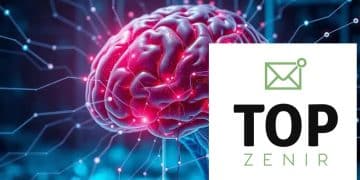Energy-efficient computing devices under development

Energy-efficient computing devices are designed to minimize energy consumption while maintaining high performance, integrating technologies like AI for smarter energy management and contributing to cost savings and environmental sustainability.
Energy-efficient computing devices under development are set to revolutionize how we think about technology consumption. Have you ever wondered how much energy your devices really use and how that impacts the environment? Let’s dive into the exciting advancements in this field.
Understanding energy-efficient computing technology
Understanding energy-efficient computing technology is vital in today’s world where digital devices dominate our lives. These advancements not only focus on performance but also on the sustainability of our tech. Are you curious about how these technologies can minimize energy usage?
The Basics of Energy-Efficient Technology
At its core, energy-efficient computing aims to reduce power consumption while maintaining the performance we expect from modern devices. This is achieved through various methods and innovations that make technology smarter and greener.
Key Innovations in Energy Efficiency
Several innovations make energy-efficient devices stand out in the market today:
- Improved microprocessor designs
- Advanced power management systems
- Utilization of renewable energy sources
- Enhanced battery technology
As we explore these innovations, it becomes clear that the journey towards energy-efficient computing is both exciting and crucial.
Why Energy Efficiency Matters
Every device we use contributes to energy consumption and affects the environment. By adopting energy-efficient technology, consumers can significantly lower their carbon footprint. This transition is not only beneficial for the planet but can also lead to cost savings on energy bills.
Understanding these technologies allows us to make informed decisions about our tech usage and supports a more sustainable future.
The Future of Energy-Efficient Computing
In the coming years, we can anticipate even greater advancements in energy-efficient computing. Companies are working tirelessly to integrate these technologies into all forms of devices, from smartphones to large data centers. As these innovations emerge, staying updated on their benefits can help maximize their positive impact.
Key benefits of energy-efficient devices

Understanding the key benefits of energy-efficient devices helps us appreciate why they’re becoming essential in our daily lives. These devices are designed to consume less energy while delivering the same level of performance, making them a win-win for both users and the environment.
Environmental Impact
First and foremost, energy-efficient devices significantly reduce electricity consumption. This decrease in energy use leads to fewer greenhouse gas emissions, contributing to a healthier planet. By using these devices, you play a role in decreasing overall energy demand, which is critical in combating climate change.
Cost Savings
Investing in energy-efficient technology can also lead to substantial cost savings. With lower energy bills, consumers can save money in the long run. Many devices are designed to operate effectively while using less power, allowing for savings that add up over time. Here are some examples of potential savings:
- Up to 30% reduction in electricity costs
- Longer lifespan of appliances, reducing replacement frequency
- Potential tax credits or rebates offered for energy-efficient upgrades
Moreover, energy-efficient devices often require less maintenance, which further reduces costs, providing both financial relief and peace of mind.
Enhanced Performance
Another significant advantage is that many energy-efficient devices are equipped with advanced technology that enhances performance. For example, energy-efficient computers can perform tasks faster while using less energy. This means that users can expect better results without sacrificing functionality.
Additionally, many of these devices come with features that allow for better energy management, making it easier for users to monitor their energy consumption. This increased awareness can lead to more sustainable habits.
Overall, the transition to energy-efficient devices not only supports a more sustainable environment but also provides financial benefits and improved performance, marrying innovation with responsibility.
Innovations driving energy-efficient computing
Innovations driving energy-efficient computing are crucial as technology evolves. These advancements focus on reducing energy consumption while enhancing performance and functionality. Curious about what these innovations entail?
Next-Gen Processors
One major innovation is the development of next-gen processors that are designed to consume less power. These processors use advanced architecture and manufacturing techniques, allowing them to perform tasks efficiently without overloading on energy. They adapt dynamically to workloads, ensuring optimal energy use.
Power Management Techniques
Another significant advancement is in power management techniques. Modern devices include features that automatically adjust performance based on user needs. For instance:
- Adaptive brightness in screens based on ambient light
- Sleep modes that activate during inactivity
- Dynamic voltage and frequency scaling (DVFS)
- Smart scheduling to wake up devices only when needed
These features help minimize energy use without sacrificing user experience, making devices more reliable and eco-friendly.
Energy Harvesting Technologies
Additionally, energy harvesting technologies are making strides. Devices now incorporate methods to capture energy from their surroundings, like solar power or kinetic energy from movement. This capability allows devices to recharge themselves in a sustainable manner, reducing reliance on traditional power sources.
Using these innovations, energy-efficient computing not only improves device performance but also contributes significantly to reducing our overall energy footprint. As these technologies evolve, they promise a future where affordability and sustainability go hand in hand, leading to smarter decisions for consumers.
Challenges in the development of these devices

The development of energy-efficient devices faces several challenges that can hinder progress. Understanding these challenges helps us appreciate the complexities involved in creating sustainable technology.
Technological Limitations
One major challenge is the technological limitations that innovators face. Despite advanced research, there are still barriers in designing hardware that effectively reduces energy consumption without sacrificing performance. For example, many existing components generate heat, requiring additional energy to cool them down, which counteracts energy-saving efforts.
Cost Considerations
Another significant issue is cost. Developing energy-efficient technology often requires expensive materials or advanced manufacturing processes. These costs can make the final product more expensive for consumers, which can discourage widespread adoption. Price sensitivity is especially crucial in markets where affordability takes precedence over sustainability.
To mitigate this, manufacturers are exploring various funding and incentive programs that can help offset initial production costs. By collaborating with government programs, companies can make their technology more accessible.
Market Demand
Market demand also plays a crucial role in this development. Consumers may prioritize functionality or price over energy efficiency, leading manufacturers to focus on aspects that drive immediate sales. Here, education becomes vital; increasing awareness about the benefits of energy-efficient devices can help shift consumer preferences.
Moreover, there is a complex ecosystem of regulations and standards that manufacturers must navigate, which can slow down the development process. Each region may have different regulations regarding energy consumption and sustainability targets.
Despite these challenges, the push for energy-efficient computing continues as organizations recognize the long-term benefits for both the environment and their bottom line. Innovators are working tirelessly to overcome these hurdles, aiming for a more sustainable future.
Future trends in energy-efficient technology
Future trends in energy-efficient technology promise exciting advancements that will reshape our digital landscape. As society becomes more aware of environmental issues, tech companies are highly motivated to innovate. What can we expect from this evolving field?
Artificial Intelligence Integration
One significant trend is the integration of artificial intelligence (AI) in energy management systems. AI can analyze data in real-time, allowing devices to optimize their energy use based on need. For example, smart thermostats adjust the heating and cooling of spaces more efficiently. This not only saves energy but also enhances user comfort.
Smart Infrastructure Development
Another trend is the push towards smart infrastructure. Cities around the world are adopting smart grids that can distribute energy more efficiently. These grids help integrate renewable energy sources such as solar and wind. By doing so, they reduce reliance on fossil fuels and improve sustainability.
In residential areas, smart homes equipped with energy-efficient appliances will become more prevalent. These homes will showcase interconnected devices that communicate and optimize energy consumption in real-time.
Energy Storage Solutions
The demand for better energy storage solutions is also gaining momentum. Technologies like advanced batteries will enable the storage of excess energy generated during peak production times. This energy can then be used later when demand is higher.
- Improved battery efficiency and lifespan
- Integration of energy storage with renewable energy systems
- Use of secondary-life batteries for additional savings
As innovation in energy storage progresses, it will enhance the overall efficiency of energy systems in homes and businesses.
Overall, the future of energy-efficient technology is bright, marked by intelligent systems, smart infrastructure, and sustainable practices. By adopting these trends, society can support a greener planet while still enjoying the conveniences of modern technology.
In conclusion, the journey towards energy-efficient computing devices is vital for a sustainable future. With advancements in technology, such as AI integration and smart infrastructure, we are on the brink of a major transformation. As we embrace these innovations, we can expect significant benefits, including cost savings and a reduced environmental impact. By tackling the existing challenges and focusing on future trends, we can make meaningful strides towards creating a greener planet. Embracing energy-efficient technology is not just an option—it’s a necessity for responsible living.
FAQ – Frequently Asked Questions about Energy-Efficient Computing
What are energy-efficient devices?
Energy-efficient devices are designed to use less electricity while providing the same performance, contributing to reduced energy costs and environmental impact.
How do AI technologies enhance energy efficiency?
AI technologies optimize device performance by analyzing data and adjusting energy consumption in real-time, leading to smarter and more efficient operations.
What is smart infrastructure?
Smart infrastructure refers to systems that use technology to manage energy distribution intelligently, including smart grids that help integrate renewable energy sources.
What are the long-term benefits of investing in energy-efficient technology?
Investing in energy-efficient technology can lead to significant cost savings, lower carbon emissions, and improved sustainability in operations.





